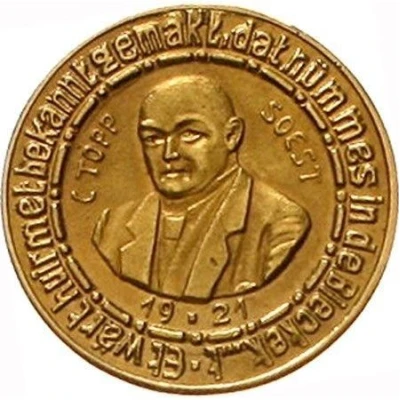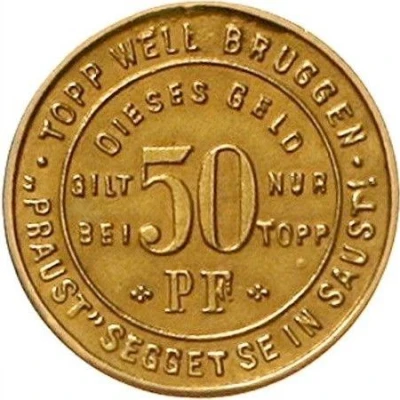


© Teutoburger Münzauktion
50 Pfennigs - Soest C. Topp - Pattern
1921 year| Gold (.930) | 8.19 g | 23 mm |
| Issuer | City of Soest (notgeld) (Prussian province of Westphalia) |
|---|---|
| Period | Weimar Republic (1918-1933) |
| Type | Pattern |
| Year | 1921 |
| Value | 50 Pfennigs (50 Pfennige) (0.50) |
| Currency | Mark (1914-1924) |
| Composition | Gold (.930) |
| Weight | 8.19 g |
| Diameter | 23 mm |
| Shape | Round |
| Technique | Milled |
| Orientation | Medal alignment ↑↑ |
| Demonetized | Yes |
| Updated | 2024-10-04 |
| Numista | N#313054 |
|---|---|
| Rarity index | 97% |
Reverse
Script: Latin
Lettering:
Dieses Geld gilt nur bei Topp
50 Pf
Topp Well Brüggen
'Praust' Segget Se In Saust
Edge
Plain
Interesting fact
One interesting fact about the Pattern 50 Pfennigs - Soest (C. Topp - Pattern) 1921 coin is that it was minted during a time of economic turmoil in Germany, specifically during the hyperinflation period of the early 1920s. The coin's value of 50 pfennigs was significant at the time, as it was equivalent to about 1/20th of a gold mark, which was the official currency of Germany at the time. Despite being made of gold, the coin's value was not stable and fluctuated greatly due to the economic conditions. Today, this coin is a rare and valuable collector's item, and its historical significance makes it an interesting piece of numismatic history.